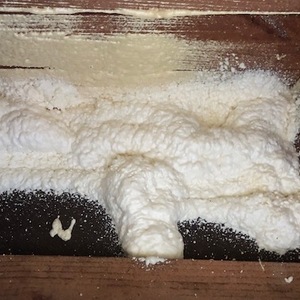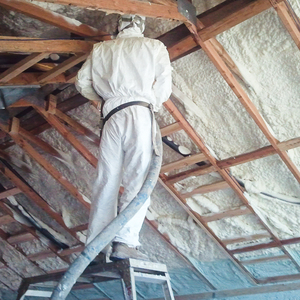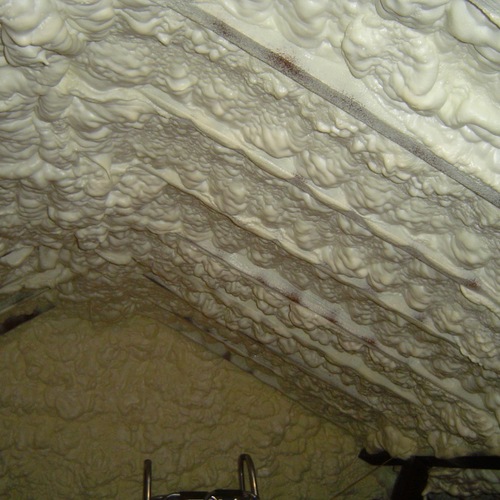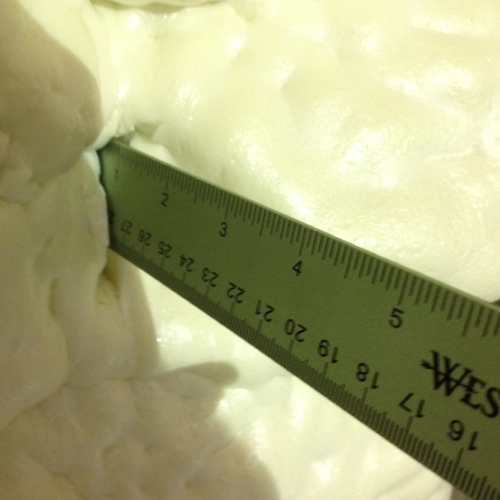
DIY kits allow homeowners to apply spray foam insulation without hiring a professional installer. But there are a few things to keep in mind before pulling the trigger. Photo: Photo credit: S. Davis / CC BY-NC-ND / Flickr
Andy Fellenz is doing some insulation and air-sealing at the rim joist of his house, and he thinks it might be a good opportunity to use a spray foam kit—an option somewhere between canned foam used to seal windows and doors, and a full-fledged professional foam installation.
In this recent Q&A post, Fellenz says: “I have installed 3-1/2-in. polyiso blocking to the rim joist between the floor joists and would like to put a layer of foam over the blocking to seal the blocking in and deal with any penetrations through the rim joist and bottom plate leading to the first floor.
“I’m also planning to use some foam to seal in some foam blocking that is above my top plate on the wall in a few locations,” he continues, “especially where I will have a cathedral ceiling.”
In all, Fellenz thinks he’ll need about 300 board feet of the material.
What are the best brands of foam on the market, he asks, and what’s the best way to tackle this job? That’s where this Q&A Spotlight begins.
Make sure the kit is warm
Although Zephyr7 would be more likely to use canned foam to seal foam blocks at the rim joist, he says he has used DuPont Froth-Paks a number of times with good results.
He offers a few tips:
Weekly Newsletter
Get building science and energy efficiency advice, plus special offers, in your inbox.

This article is only available to GBA Prime Members
Sign up for a free trial and get instant access to this article as well as GBA’s complete library of premium articles and construction details.
Start Free TrialAlready a member? Log in















5 Comments
Thank you to Henri Fennell for the great news that there are now HFO versions of the DIY kits available, and for adding the note about making sure that if you use board insulation to reduce GWP, you get the right boards. I had included that note in my original comment, but it got lost in the edit, so I am glad to have that important caveat clearly noted here as well as in the original Q&A.
I disagree with Henri Fennell's last paragraph. There are a lot of good reasons to limit the use of spray foam to situations when it is the only possible solution, and I think Robert delineated them pretty well.
With the exception of SIPS, spray foam is the only product I can think of that regularly damages houses beyond remediation.
I agree 100% with Mr. Taylor's comment. As a CIH who has consulted on failed installs, failed structures due to hidden deterioration, failed installs due to inadequate ventilation, and as a seasoned DIYer who generally is unafraid to undertake new adventures, don't attempt to DIY spray foam. As pointed out, the cost of failure is extreme. Pay a professional and insist they follow to the letter the industry standards for safety, ventilation, etc. If you sense any hesitancy when you broach the topic of ventilation, find someone else. And I would find an experienced architect to verify the application from a building science perspective. No ambivalence here.
I agree with the idea of using spray foam as little as possible and only when there is no good alternative. In addition to the high GPW, high density foam is irreversible and it renders everything it’s applied to non-reusable. End of life is also a concern; this stuff seems very environmentally unfriendly to dispose of.
That said I have successfully used several kits of DYI foam on 3 different occasions on old stone basement wall foundations and once for a basement under-slab where I wanted a moisture and thermal break with as little added height (and labor) as possible. In each case I sprayed it only about 1” thick. It’s been quite successful; I’ve turned one of these basements into my living space and occupied it for the past 12 years. In my cases the main benefit of spray foam is that it encapsulated the old and slightly crumbly stone foundation, stopped air infiltrations, pests, and “sweaty wall” in summer. In two cases -although I wouldn’t guarantee the result- it even took care of water infiltration issues.
I bought my kits from EFI -see link below. Those kits say nothing about GPW so I assume it’s not good. I followed the instruction and the spraying worked out fine although I never seemed to get close to the advertised 600 Board foot of foam, I estimated closer to 400. Also, no matter what I did to try to adjust it, one of the tanks (can’t remember if it was part A or B) would always run out when there was about 1/5 left in the other.
https://wholesale.poweredbyefi.org/handifoam-605-bd-ft-hfo-e84-2-component-spray-foam-a-b-cylinders-only.html
Good overview, but I also have to disagree with Henri Fennell's last sentence. While I specify foam frequently, when there are no reasonable alternatives, in most cases there ARE reasonable alternative. We discuss them here on GBA daily.
There is a lot of marketing effort by foam manufacturers that focuses on the low GWP of the blowing agents in foam, which is indeed a good development. But there is more to up-front carbon emissions of foam than the blowing agents, and foams of all types--INCLUDING NGX AND HFO-BLOWN FOAMS--are still some of the most climate-damaging materials we use in construction.
The health risks are serious--spray foam installers should use a supplied-air respirator, not just a regular cartridge respirator, and you'd better cross your fingers that the foam cures properly. When it doesn't, it's a big problem.
Trying to save the planet one house at a time is not realistic, so here's how I prioritize when making decisions:
1. Occupant health. Don't use materials that are detrimental to health, and preferably use materials and designs that promote good health.
2. Building durability. Don't use assemblies or materials that will lead to moisture-related or other problems, or that limit future changes to the building--it almost certainly will be renovated at some point.
3. Environmental impact. When there are multiple materials or assemblies to choose from, and the cost is reasonably equivalent, choose the one with the lowest environmental impact, prioritizing short-term climate impact due to the climate crisis rather than assessing on a 100+ year scale.
Using those priorities, I find that foam is rarely necessary above grade, and can easily be minimized or sometimes eliminated below grade.
Log in or become a member to post a comment.
Sign up Log in